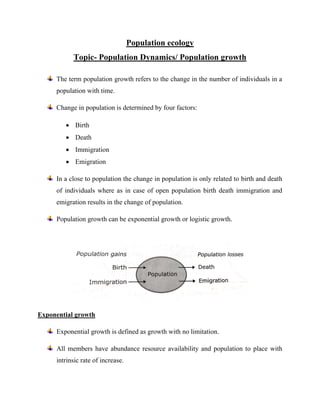
Population dynamics
- 1. Population ecology Topic- Population Dynamics/ Population growth The term population growth refers to the change in the number of individuals in a population with time. Change in population is determined by four factors: • Birth • Death • Immigration • Emigration In a close to population the change in population is only related to birth and death of individuals where as in case of open population birth death immigration and emigration results in the change of population. Population growth can be exponential growth or logistic growth. Exponential growth Exponential growth is defined as growth with no limitation. All members have abundance resource availability and population to place with intrinsic rate of increase.
- 2. Exponential growth in the number increase in geometric progression 20 , 21 , 22 , 23 … it is constant fraction. By contrast, a pattern of growth that increases at constant amount per unit of time called arithmetic growth. Exponential growth can be expressed by the given equation: Where, n= Population size r= intrinsic rate of natural increase In a closed population, r is defined as the instantaneous per capita birth rate (b) minus the instantaneous per capita death rate (d). Similarly, in an open population r is equal to (Birth + Immigration) - (Death + Emigration). When resources such as food and space in a habitat are unlimited, all members of a species have the ability to grow exponentially. The population size that increases exponentially at a constant rate, results in a J- shaped growth curve when population size (N) is plotted over time (t).
- 3. Logistic growth As population density increases, each individual has access to fewer resources. It means a particular environment can only support a maximum population size. The number of individuals of a particular species that a particular environment can support indefinitely is defined as carrying capacity (represented by the letter K). Carrying capacity is not fixed, but varies over space and time with the abundance of limiting sources resources. It is determined by various factors including predation, competition and climatic conditions. (a) Change in population size (N) through time as predicted by the logistic model of population growth. Initially (low values of N), the population grows exponentially as N increases the rate of population growth decreases, eventually reaching zero as the population size approaches the carrying capacity (K). (b) The relationship between the rate of population growth, dN/dt and population size N, takes the form of a parabola, reaching a maximum value at a population size of N = K/2. The rate of population growth (dN/dt) is at its highest when N=K/2 (called the inflection point) and then decreases as it approaches the carrying capacity (K).
- 4. Population regulation Population ecologists have identified a number of mechanisms by which populations could be regulated. Broadly speaking, factors regulating population growth are either density- dependant or density-dependant. Density-dependent factors are those whose effects on the birth rate or death rate change as a function of the population density. These factors include disease, competition for space, water and nutritions and predation. For example, a population of rabbits may increase exponentially until competitive intraspecific interactions cause either the birth rate to decrease or the death rate to increase, leading to a net decline in reproductive rate and subsequent decrease in population density. Density-dependent factors can have either a positive or a negative correlation to population size. As population size increases, either birth rate decline or mortality rate increases or both. It is a negative feedback. However, not always density dependent factors are negatively related to population size. In some cases, growth rate increases with population size. This phenomenon is referred to as the Allee effect (after W. Allee, who first described it) and is an example of positive feedback. Positive relationships between fitness and population size can be caused by a variety of mechanisms that affect reproductive and survival. Density-independent factors affect population growth, irrespective of the density of the population. These factors are usually associated with abiotic events- changes in the physical environment that either promotes or repress population growth, but their effects are independent of population density it may include natural catastrophes such as hurricanes, floods and seasonal variation in weather pattern.
- 5. r-strategists and k-strategists The concept of r-strategists and k-strategists links population dynamics to life history. A strongly variable and unpredictable environments lead to a highly fluctuating population density. These conditions select for a high intrinsic growth rate r which is achieved by a distinctive life -history strategy consisting of rapid development, a small body size, early reproduction, semelparity and a short life span (usually with a life span of less than a year). Species with this reproductive pattern overcome the massive loss of their offspring by producing so many unprotected young that a few will survive to reproduce many offspring to begin the cycle again. Species with these characteristics are called r-strategists. Algae, bacteria, rodents, annual plants (such as dandelions) and
- 6. most insects are r-strategists. Such species tend to be opportunities. They reproduce and disperse rapidly when conditions are favorable. On the other hand, relatively constant or predictable environmental conditions allow a population to reach its carrying capacity K and thus a high average population density. The concept says that these conditions select for a high K, which is achieved by slow development (associated with great competition ability), a large body size, delayed reproduction, iteroparity and a long life span. Species with these characteristics are called K-strategists. These species spent fairly little energy into reproduction and put most of their energy into nurturing and protecting their young until they reach reproductive age.